Apply Legal Principles in Property Law - AECL002 Re-Assessment 1
VerifiedAdded on 2022/08/24
|16
|3446
|22
Homework Assignment
AI Summary
This document presents a comprehensive solution to a property law assignment, addressing various key legal principles. The assignment delves into the differences between contract law, tort law, and criminal law, exploring their distinct characteristics and applications. It further analyzes the hierarchy of court decisions and their binding effects. The solution also explains different types of property ownership, including fee simple estates, life estates, joint tenancy, and tenancy in common, with illustrative examples. Furthermore, it examines the remedies available to a mortgagee when a mortgagor defaults, the distinctions between residential and commercial tenancies, and the positive and negative aspects of easements, including their creation and termination. The assignment also covers the purpose and utility of the National Personal Property Securities Register (PPSR) for businesses, the standard of care required of a bailee, and liability in bailment scenarios. Finally, it explains the concept of national treatment in copyright law, providing a detailed understanding of various property law concepts.
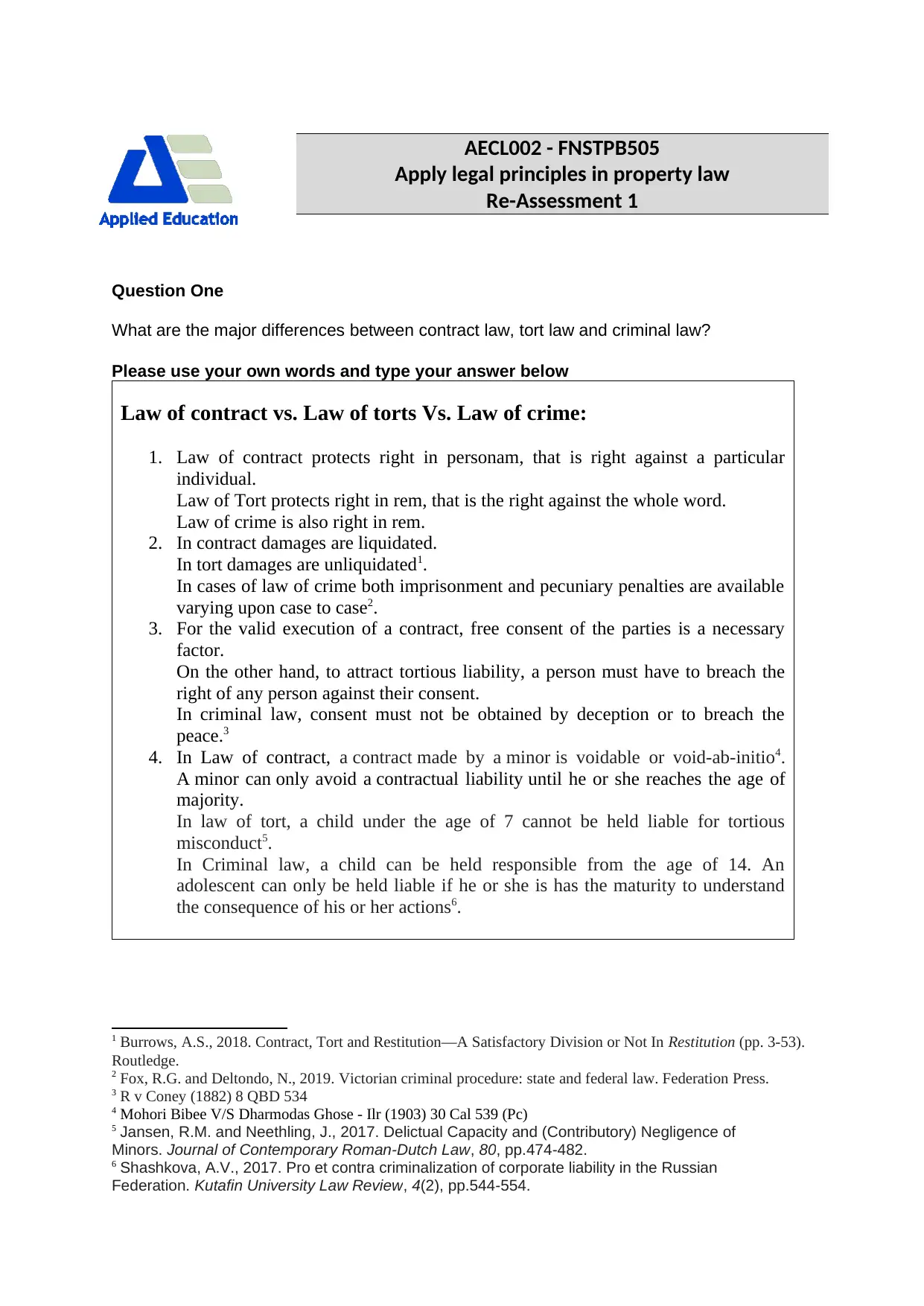
AECL002 - FNSTPB505
Apply legal principles in property law
Re-Assessment 1
Question One
What are the major differences between contract law, tort law and criminal law?
Please use your own words and type your answer below
Law of contract vs. Law of torts Vs. Law of crime:
1. Law of contract protects right in personam, that is right against a particular
individual.
Law of Tort protects right in rem, that is the right against the whole word.
Law of crime is also right in rem.
2. In contract damages are liquidated.
In tort damages are unliquidated1.
In cases of law of crime both imprisonment and pecuniary penalties are available
varying upon case to case2.
3. For the valid execution of a contract, free consent of the parties is a necessary
factor.
On the other hand, to attract tortious liability, a person must have to breach the
right of any person against their consent.
In criminal law, consent must not be obtained by deception or to breach the
peace.3
4. In Law of contract, a contract made by a minor is voidable or void-ab-initio4.
A minor can only avoid a contractual liability until he or she reaches the age of
majority.
In law of tort, a child under the age of 7 cannot be held liable for tortious
misconduct5.
In Criminal law, a child can be held responsible from the age of 14. An
adolescent can only be held liable if he or she is has the maturity to understand
the consequence of his or her actions6.
1 Burrows, A.S., 2018. Contract, Tort and Restitution—A Satisfactory Division or Not In Restitution (pp. 3-53).
Routledge.
2 Fox, R.G. and Deltondo, N., 2019. Victorian criminal procedure: state and federal law. Federation Press.
3 R v Coney (1882) 8 QBD 534
4 Mohori Bibee V/S Dharmodas Ghose - Ilr (1903) 30 Cal 539 (Pc)
5 Jansen, R.M. and Neethling, J., 2017. Delictual Capacity and (Contributory) Negligence of
Minors. Journal of Contemporary Roman-Dutch Law, 80, pp.474-482.
6 Shashkova, A.V., 2017. Pro et contra criminalization of corporate liability in the Russian
Federation. Kutafin University Law Review, 4(2), pp.544-554.
Apply legal principles in property law
Re-Assessment 1
Question One
What are the major differences between contract law, tort law and criminal law?
Please use your own words and type your answer below
Law of contract vs. Law of torts Vs. Law of crime:
1. Law of contract protects right in personam, that is right against a particular
individual.
Law of Tort protects right in rem, that is the right against the whole word.
Law of crime is also right in rem.
2. In contract damages are liquidated.
In tort damages are unliquidated1.
In cases of law of crime both imprisonment and pecuniary penalties are available
varying upon case to case2.
3. For the valid execution of a contract, free consent of the parties is a necessary
factor.
On the other hand, to attract tortious liability, a person must have to breach the
right of any person against their consent.
In criminal law, consent must not be obtained by deception or to breach the
peace.3
4. In Law of contract, a contract made by a minor is voidable or void-ab-initio4.
A minor can only avoid a contractual liability until he or she reaches the age of
majority.
In law of tort, a child under the age of 7 cannot be held liable for tortious
misconduct5.
In Criminal law, a child can be held responsible from the age of 14. An
adolescent can only be held liable if he or she is has the maturity to understand
the consequence of his or her actions6.
1 Burrows, A.S., 2018. Contract, Tort and Restitution—A Satisfactory Division or Not In Restitution (pp. 3-53).
Routledge.
2 Fox, R.G. and Deltondo, N., 2019. Victorian criminal procedure: state and federal law. Federation Press.
3 R v Coney (1882) 8 QBD 534
4 Mohori Bibee V/S Dharmodas Ghose - Ilr (1903) 30 Cal 539 (Pc)
5 Jansen, R.M. and Neethling, J., 2017. Delictual Capacity and (Contributory) Negligence of
Minors. Journal of Contemporary Roman-Dutch Law, 80, pp.474-482.
6 Shashkova, A.V., 2017. Pro et contra criminalization of corporate liability in the Russian
Federation. Kutafin University Law Review, 4(2), pp.544-554.
Paraphrase This Document
Need a fresh take? Get an instant paraphrase of this document with our AI Paraphraser
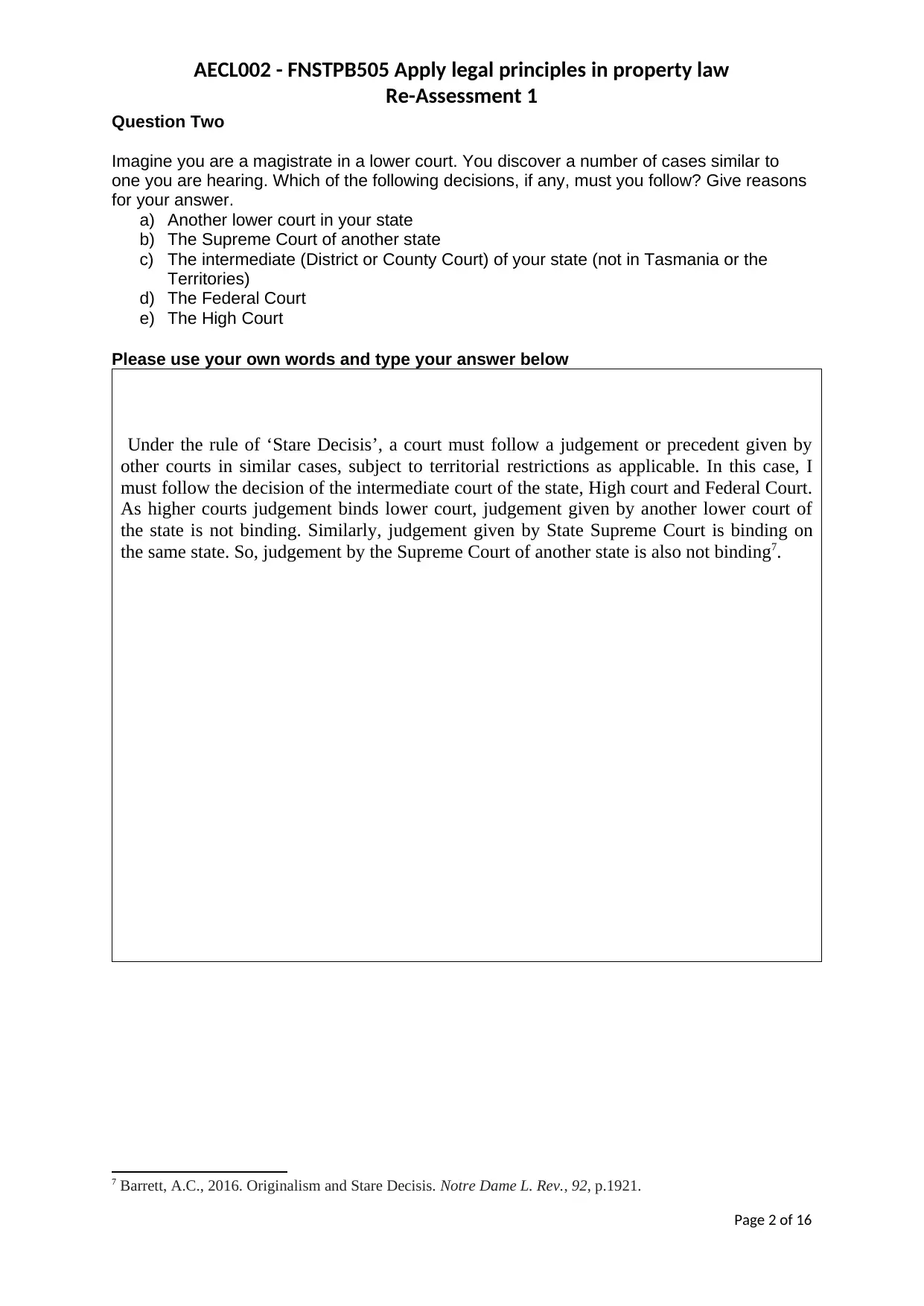
AECL002 - FNSTPB505 Apply legal principles in property law
Re-Assessment 1
Question Two
Imagine you are a magistrate in a lower court. You discover a number of cases similar to
one you are hearing. Which of the following decisions, if any, must you follow? Give reasons
for your answer.
a) Another lower court in your state
b) The Supreme Court of another state
c) The intermediate (District or County Court) of your state (not in Tasmania or the
Territories)
d) The Federal Court
e) The High Court
Please use your own words and type your answer below
Under the rule of ‘Stare Decisis’, a court must follow a judgement or precedent given by
other courts in similar cases, subject to territorial restrictions as applicable. In this case, I
must follow the decision of the intermediate court of the state, High court and Federal Court.
As higher courts judgement binds lower court, judgement given by another lower court of
the state is not binding. Similarly, judgement given by State Supreme Court is binding on
the same state. So, judgement by the Supreme Court of another state is also not binding7.
7 Barrett, A.C., 2016. Originalism and Stare Decisis. Notre Dame L. Rev., 92, p.1921.
Page 2 of 16
Re-Assessment 1
Question Two
Imagine you are a magistrate in a lower court. You discover a number of cases similar to
one you are hearing. Which of the following decisions, if any, must you follow? Give reasons
for your answer.
a) Another lower court in your state
b) The Supreme Court of another state
c) The intermediate (District or County Court) of your state (not in Tasmania or the
Territories)
d) The Federal Court
e) The High Court
Please use your own words and type your answer below
Under the rule of ‘Stare Decisis’, a court must follow a judgement or precedent given by
other courts in similar cases, subject to territorial restrictions as applicable. In this case, I
must follow the decision of the intermediate court of the state, High court and Federal Court.
As higher courts judgement binds lower court, judgement given by another lower court of
the state is not binding. Similarly, judgement given by State Supreme Court is binding on
the same state. So, judgement by the Supreme Court of another state is also not binding7.
7 Barrett, A.C., 2016. Originalism and Stare Decisis. Notre Dame L. Rev., 92, p.1921.
Page 2 of 16
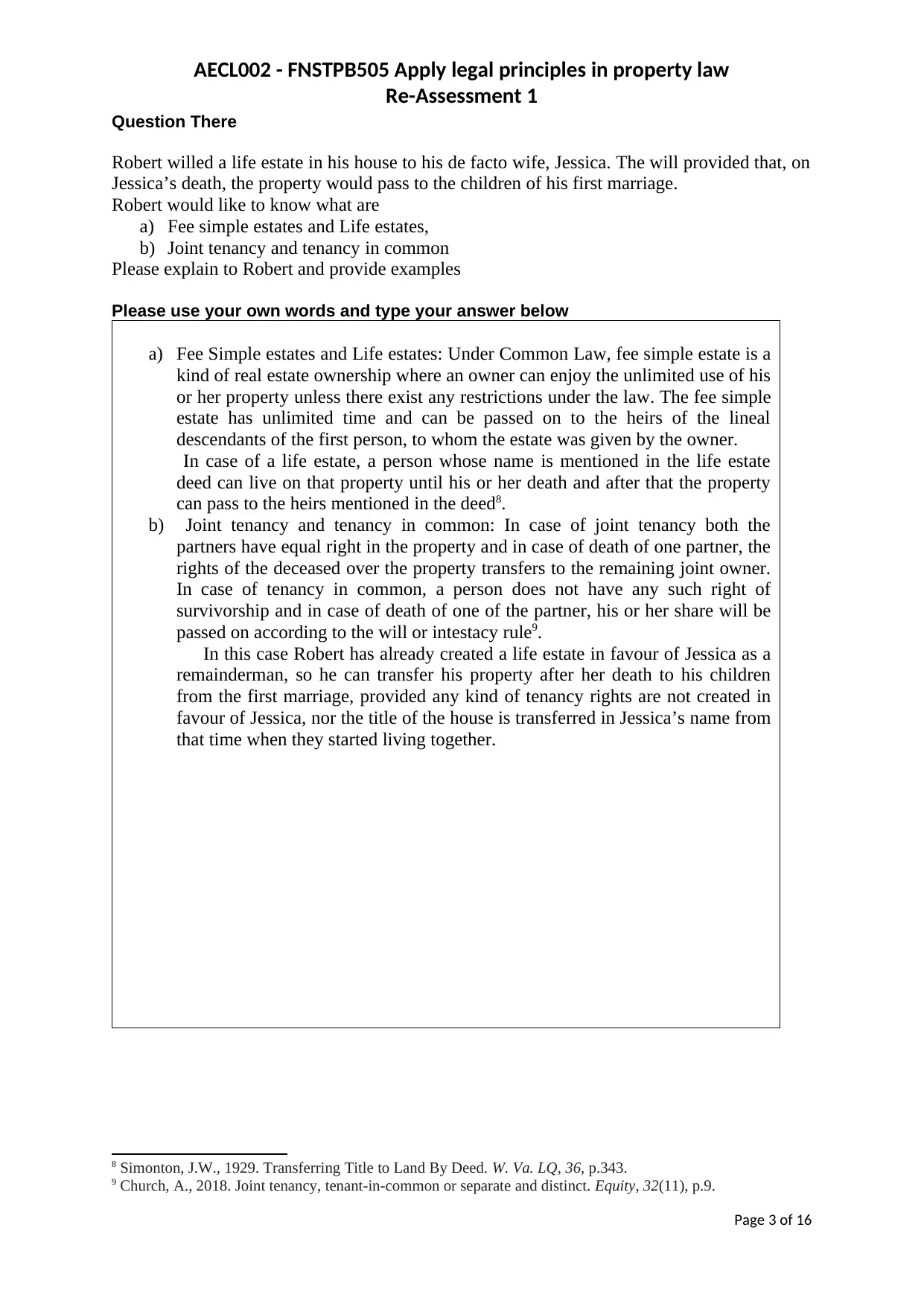
AECL002 - FNSTPB505 Apply legal principles in property law
Re-Assessment 1
Question There
Robert willed a life estate in his house to his de facto wife, Jessica. The will provided that, on
Jessica’s death, the property would pass to the children of his first marriage.
Robert would like to know what are
a) Fee simple estates and Life estates,
b) Joint tenancy and tenancy in common
Please explain to Robert and provide examples
Please use your own words and type your answer below
a) Fee Simple estates and Life estates: Under Common Law, fee simple estate is a
kind of real estate ownership where an owner can enjoy the unlimited use of his
or her property unless there exist any restrictions under the law. The fee simple
estate has unlimited time and can be passed on to the heirs of the lineal
descendants of the first person, to whom the estate was given by the owner.
In case of a life estate, a person whose name is mentioned in the life estate
deed can live on that property until his or her death and after that the property
can pass to the heirs mentioned in the deed8.
b) Joint tenancy and tenancy in common: In case of joint tenancy both the
partners have equal right in the property and in case of death of one partner, the
rights of the deceased over the property transfers to the remaining joint owner.
In case of tenancy in common, a person does not have any such right of
survivorship and in case of death of one of the partner, his or her share will be
passed on according to the will or intestacy rule9.
In this case Robert has already created a life estate in favour of Jessica as a
remainderman, so he can transfer his property after her death to his children
from the first marriage, provided any kind of tenancy rights are not created in
favour of Jessica, nor the title of the house is transferred in Jessica’s name from
that time when they started living together.
8 Simonton, J.W., 1929. Transferring Title to Land By Deed. W. Va. LQ, 36, p.343.
9 Church, A., 2018. Joint tenancy, tenant-in-common or separate and distinct. Equity, 32(11), p.9.
Page 3 of 16
Re-Assessment 1
Question There
Robert willed a life estate in his house to his de facto wife, Jessica. The will provided that, on
Jessica’s death, the property would pass to the children of his first marriage.
Robert would like to know what are
a) Fee simple estates and Life estates,
b) Joint tenancy and tenancy in common
Please explain to Robert and provide examples
Please use your own words and type your answer below
a) Fee Simple estates and Life estates: Under Common Law, fee simple estate is a
kind of real estate ownership where an owner can enjoy the unlimited use of his
or her property unless there exist any restrictions under the law. The fee simple
estate has unlimited time and can be passed on to the heirs of the lineal
descendants of the first person, to whom the estate was given by the owner.
In case of a life estate, a person whose name is mentioned in the life estate
deed can live on that property until his or her death and after that the property
can pass to the heirs mentioned in the deed8.
b) Joint tenancy and tenancy in common: In case of joint tenancy both the
partners have equal right in the property and in case of death of one partner, the
rights of the deceased over the property transfers to the remaining joint owner.
In case of tenancy in common, a person does not have any such right of
survivorship and in case of death of one of the partner, his or her share will be
passed on according to the will or intestacy rule9.
In this case Robert has already created a life estate in favour of Jessica as a
remainderman, so he can transfer his property after her death to his children
from the first marriage, provided any kind of tenancy rights are not created in
favour of Jessica, nor the title of the house is transferred in Jessica’s name from
that time when they started living together.
8 Simonton, J.W., 1929. Transferring Title to Land By Deed. W. Va. LQ, 36, p.343.
9 Church, A., 2018. Joint tenancy, tenant-in-common or separate and distinct. Equity, 32(11), p.9.
Page 3 of 16
⊘ This is a preview!⊘
Do you want full access?
Subscribe today to unlock all pages.

Trusted by 1+ million students worldwide
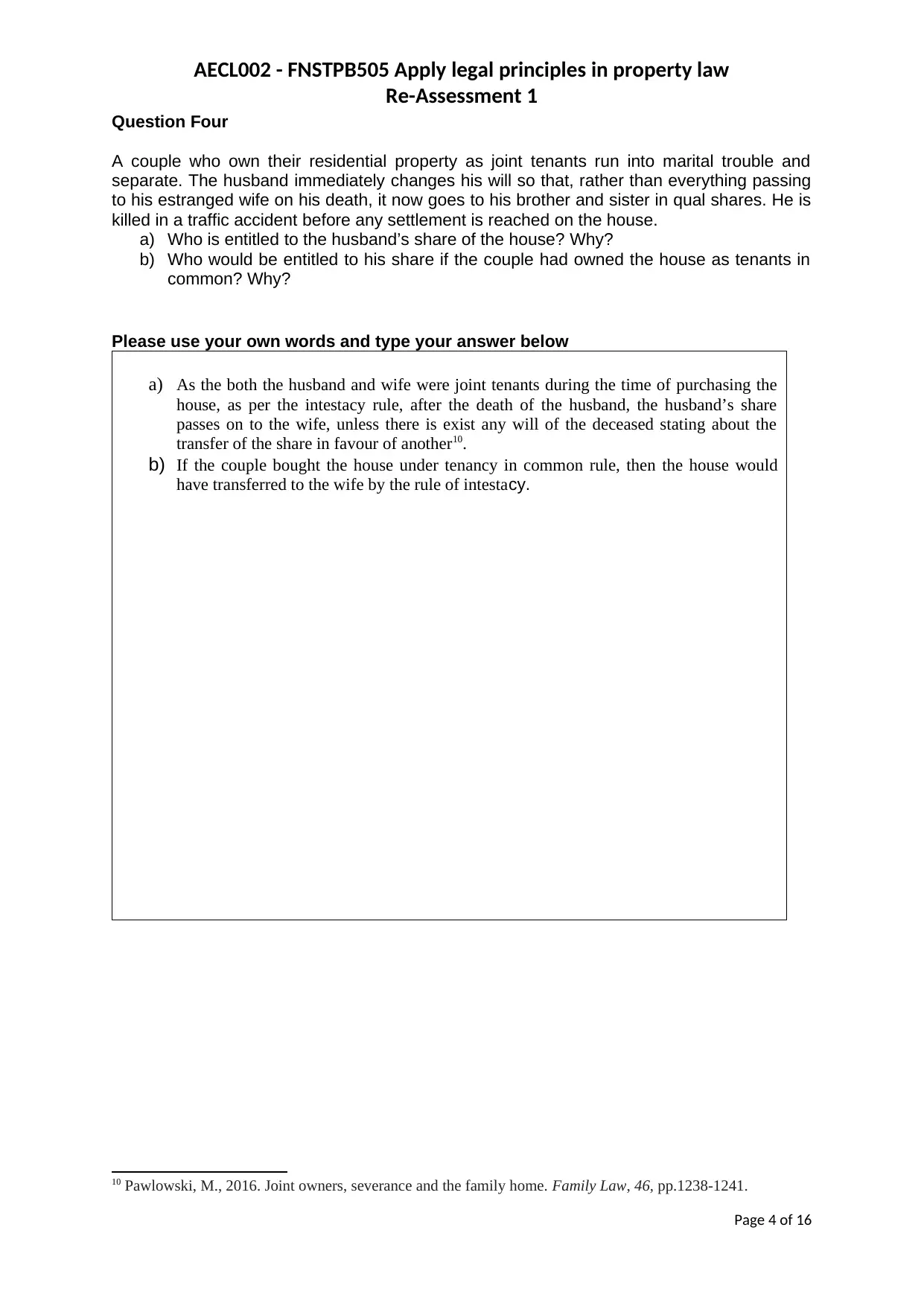
AECL002 - FNSTPB505 Apply legal principles in property law
Re-Assessment 1
Question Four
A couple who own their residential property as joint tenants run into marital trouble and
separate. The husband immediately changes his will so that, rather than everything passing
to his estranged wife on his death, it now goes to his brother and sister in qual shares. He is
killed in a traffic accident before any settlement is reached on the house.
a) Who is entitled to the husband’s share of the house? Why?
b) Who would be entitled to his share if the couple had owned the house as tenants in
common? Why?
Please use your own words and type your answer below
a) As the both the husband and wife were joint tenants during the time of purchasing the
house, as per the intestacy rule, after the death of the husband, the husband’s share
passes on to the wife, unless there is exist any will of the deceased stating about the
transfer of the share in favour of another10.
b) If the couple bought the house under tenancy in common rule, then the house would
have transferred to the wife by the rule of intestacy.
10 Pawlowski, M., 2016. Joint owners, severance and the family home. Family Law, 46, pp.1238-1241.
Page 4 of 16
Re-Assessment 1
Question Four
A couple who own their residential property as joint tenants run into marital trouble and
separate. The husband immediately changes his will so that, rather than everything passing
to his estranged wife on his death, it now goes to his brother and sister in qual shares. He is
killed in a traffic accident before any settlement is reached on the house.
a) Who is entitled to the husband’s share of the house? Why?
b) Who would be entitled to his share if the couple had owned the house as tenants in
common? Why?
Please use your own words and type your answer below
a) As the both the husband and wife were joint tenants during the time of purchasing the
house, as per the intestacy rule, after the death of the husband, the husband’s share
passes on to the wife, unless there is exist any will of the deceased stating about the
transfer of the share in favour of another10.
b) If the couple bought the house under tenancy in common rule, then the house would
have transferred to the wife by the rule of intestacy.
10 Pawlowski, M., 2016. Joint owners, severance and the family home. Family Law, 46, pp.1238-1241.
Page 4 of 16
Paraphrase This Document
Need a fresh take? Get an instant paraphrase of this document with our AI Paraphraser
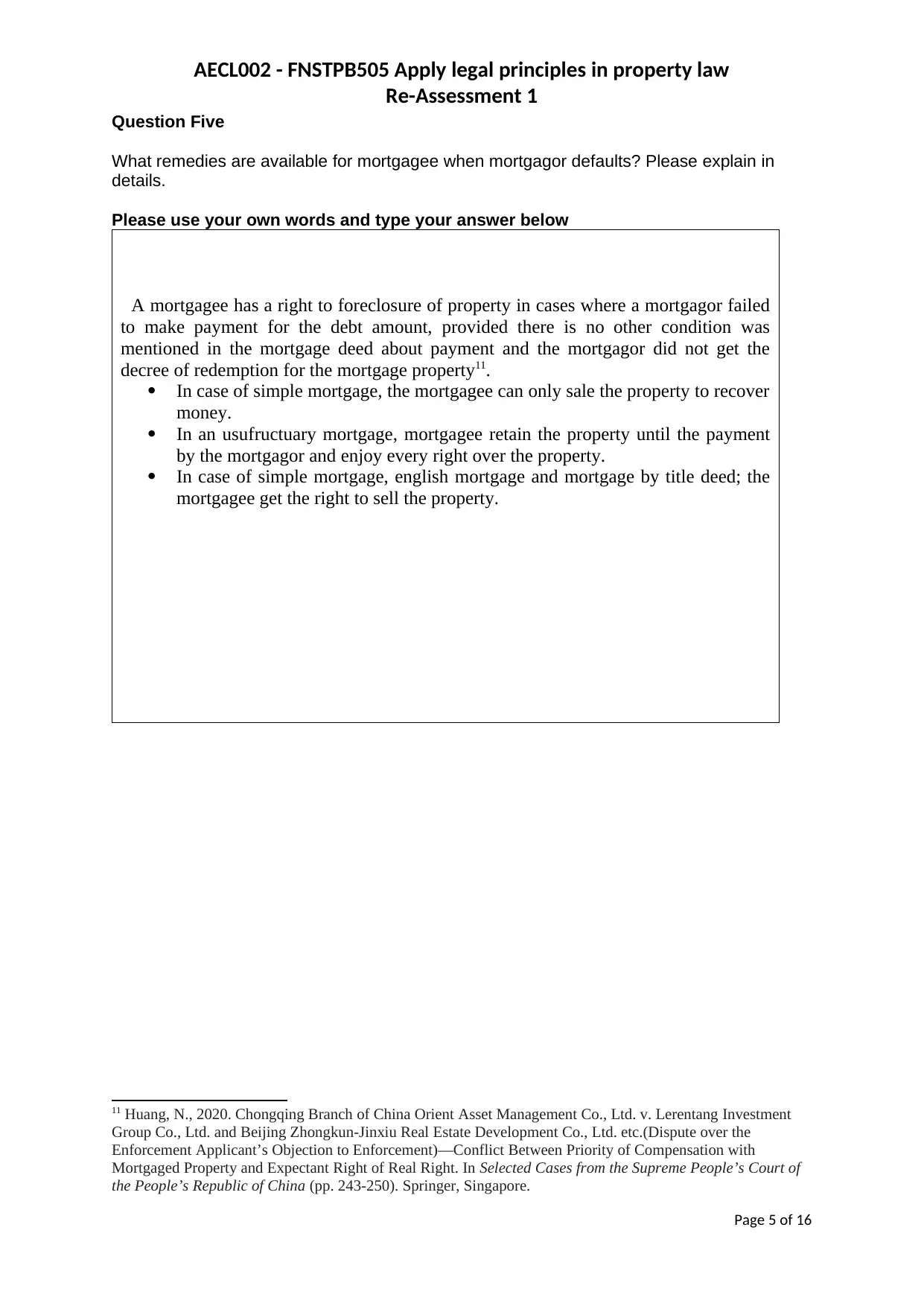
AECL002 - FNSTPB505 Apply legal principles in property law
Re-Assessment 1
Question Five
What remedies are available for mortgagee when mortgagor defaults? Please explain in
details.
Please use your own words and type your answer below
A mortgagee has a right to foreclosure of property in cases where a mortgagor failed
to make payment for the debt amount, provided there is no other condition was
mentioned in the mortgage deed about payment and the mortgagor did not get the
decree of redemption for the mortgage property11.
In case of simple mortgage, the mortgagee can only sale the property to recover
money.
In an usufructuary mortgage, mortgagee retain the property until the payment
by the mortgagor and enjoy every right over the property.
In case of simple mortgage, english mortgage and mortgage by title deed; the
mortgagee get the right to sell the property.
11 Huang, N., 2020. Chongqing Branch of China Orient Asset Management Co., Ltd. v. Lerentang Investment
Group Co., Ltd. and Beijing Zhongkun-Jinxiu Real Estate Development Co., Ltd. etc.(Dispute over the
Enforcement Applicant’s Objection to Enforcement)—Conflict Between Priority of Compensation with
Mortgaged Property and Expectant Right of Real Right. In Selected Cases from the Supreme People’s Court of
the People’s Republic of China (pp. 243-250). Springer, Singapore.
Page 5 of 16
Re-Assessment 1
Question Five
What remedies are available for mortgagee when mortgagor defaults? Please explain in
details.
Please use your own words and type your answer below
A mortgagee has a right to foreclosure of property in cases where a mortgagor failed
to make payment for the debt amount, provided there is no other condition was
mentioned in the mortgage deed about payment and the mortgagor did not get the
decree of redemption for the mortgage property11.
In case of simple mortgage, the mortgagee can only sale the property to recover
money.
In an usufructuary mortgage, mortgagee retain the property until the payment
by the mortgagor and enjoy every right over the property.
In case of simple mortgage, english mortgage and mortgage by title deed; the
mortgagee get the right to sell the property.
11 Huang, N., 2020. Chongqing Branch of China Orient Asset Management Co., Ltd. v. Lerentang Investment
Group Co., Ltd. and Beijing Zhongkun-Jinxiu Real Estate Development Co., Ltd. etc.(Dispute over the
Enforcement Applicant’s Objection to Enforcement)—Conflict Between Priority of Compensation with
Mortgaged Property and Expectant Right of Real Right. In Selected Cases from the Supreme People’s Court of
the People’s Republic of China (pp. 243-250). Springer, Singapore.
Page 5 of 16
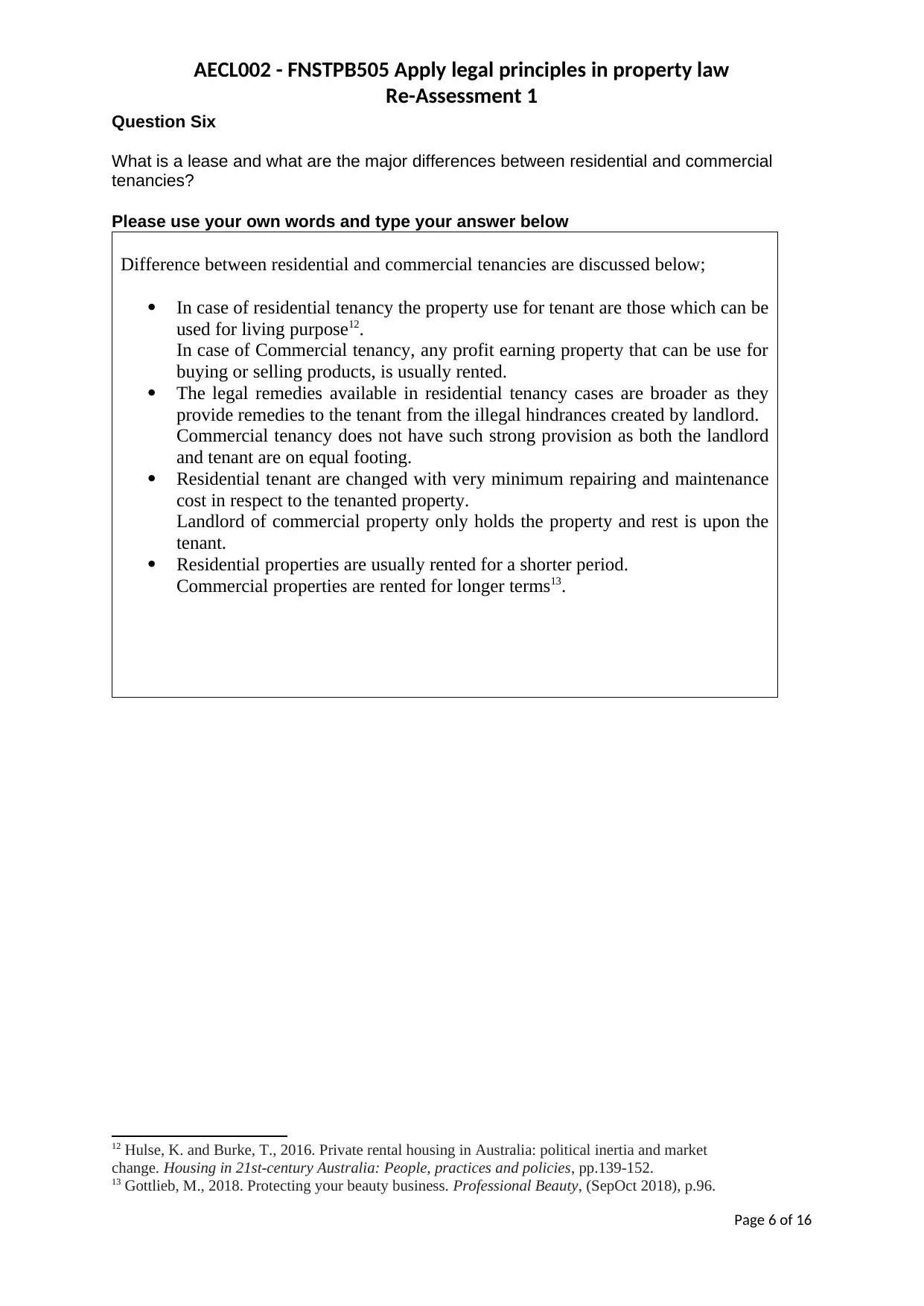
AECL002 - FNSTPB505 Apply legal principles in property law
Re-Assessment 1
Question Six
What is a lease and what are the major differences between residential and commercial
tenancies?
Please use your own words and type your answer below
Difference between residential and commercial tenancies are discussed below;
In case of residential tenancy the property use for tenant are those which can be
used for living purpose12.
In case of Commercial tenancy, any profit earning property that can be use for
buying or selling products, is usually rented.
The legal remedies available in residential tenancy cases are broader as they
provide remedies to the tenant from the illegal hindrances created by landlord.
Commercial tenancy does not have such strong provision as both the landlord
and tenant are on equal footing.
Residential tenant are changed with very minimum repairing and maintenance
cost in respect to the tenanted property.
Landlord of commercial property only holds the property and rest is upon the
tenant.
Residential properties are usually rented for a shorter period.
Commercial properties are rented for longer terms13.
12 Hulse, K. and Burke, T., 2016. Private rental housing in Australia: political inertia and market
change. Housing in 21st-century Australia: People, practices and policies, pp.139-152.
13 Gottlieb, M., 2018. Protecting your beauty business. Professional Beauty, (SepOct 2018), p.96.
Page 6 of 16
Re-Assessment 1
Question Six
What is a lease and what are the major differences between residential and commercial
tenancies?
Please use your own words and type your answer below
Difference between residential and commercial tenancies are discussed below;
In case of residential tenancy the property use for tenant are those which can be
used for living purpose12.
In case of Commercial tenancy, any profit earning property that can be use for
buying or selling products, is usually rented.
The legal remedies available in residential tenancy cases are broader as they
provide remedies to the tenant from the illegal hindrances created by landlord.
Commercial tenancy does not have such strong provision as both the landlord
and tenant are on equal footing.
Residential tenant are changed with very minimum repairing and maintenance
cost in respect to the tenanted property.
Landlord of commercial property only holds the property and rest is upon the
tenant.
Residential properties are usually rented for a shorter period.
Commercial properties are rented for longer terms13.
12 Hulse, K. and Burke, T., 2016. Private rental housing in Australia: political inertia and market
change. Housing in 21st-century Australia: People, practices and policies, pp.139-152.
13 Gottlieb, M., 2018. Protecting your beauty business. Professional Beauty, (SepOct 2018), p.96.
Page 6 of 16
⊘ This is a preview!⊘
Do you want full access?
Subscribe today to unlock all pages.

Trusted by 1+ million students worldwide
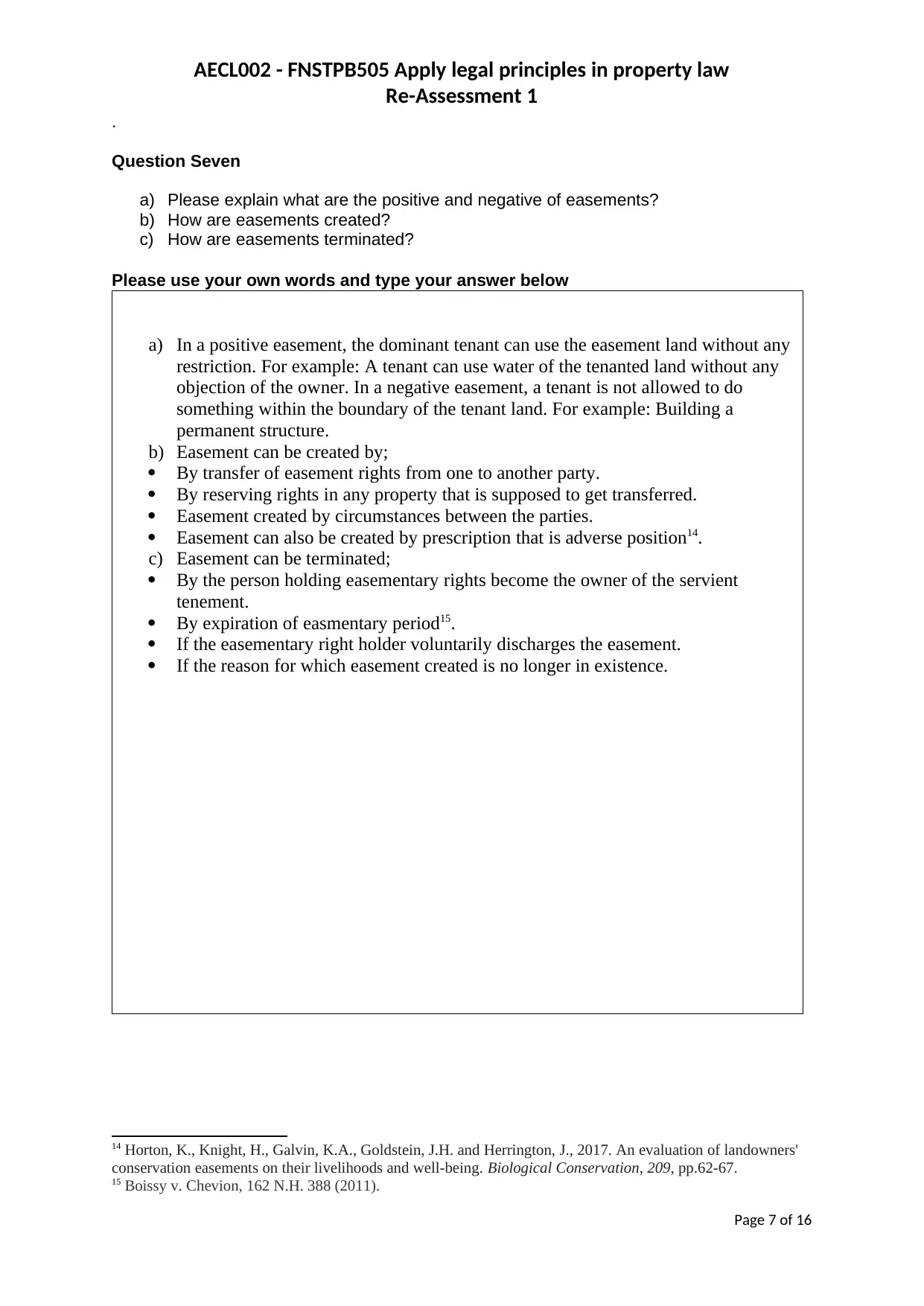
AECL002 - FNSTPB505 Apply legal principles in property law
Re-Assessment 1
.
Question Seven
a) Please explain what are the positive and negative of easements?
b) How are easements created?
c) How are easements terminated?
Please use your own words and type your answer below
a) In a positive easement, the dominant tenant can use the easement land without any
restriction. For example: A tenant can use water of the tenanted land without any
objection of the owner. In a negative easement, a tenant is not allowed to do
something within the boundary of the tenant land. For example: Building a
permanent structure.
b) Easement can be created by;
By transfer of easement rights from one to another party.
By reserving rights in any property that is supposed to get transferred.
Easement created by circumstances between the parties.
Easement can also be created by prescription that is adverse position14.
c) Easement can be terminated;
By the person holding easementary rights become the owner of the servient
tenement.
By expiration of easmentary period15.
If the easementary right holder voluntarily discharges the easement.
If the reason for which easement created is no longer in existence.
14 Horton, K., Knight, H., Galvin, K.A., Goldstein, J.H. and Herrington, J., 2017. An evaluation of landowners'
conservation easements on their livelihoods and well-being. Biological Conservation, 209, pp.62-67.
15 Boissy v. Chevion, 162 N.H. 388 (2011).
Page 7 of 16
Re-Assessment 1
.
Question Seven
a) Please explain what are the positive and negative of easements?
b) How are easements created?
c) How are easements terminated?
Please use your own words and type your answer below
a) In a positive easement, the dominant tenant can use the easement land without any
restriction. For example: A tenant can use water of the tenanted land without any
objection of the owner. In a negative easement, a tenant is not allowed to do
something within the boundary of the tenant land. For example: Building a
permanent structure.
b) Easement can be created by;
By transfer of easement rights from one to another party.
By reserving rights in any property that is supposed to get transferred.
Easement created by circumstances between the parties.
Easement can also be created by prescription that is adverse position14.
c) Easement can be terminated;
By the person holding easementary rights become the owner of the servient
tenement.
By expiration of easmentary period15.
If the easementary right holder voluntarily discharges the easement.
If the reason for which easement created is no longer in existence.
14 Horton, K., Knight, H., Galvin, K.A., Goldstein, J.H. and Herrington, J., 2017. An evaluation of landowners'
conservation easements on their livelihoods and well-being. Biological Conservation, 209, pp.62-67.
15 Boissy v. Chevion, 162 N.H. 388 (2011).
Page 7 of 16
Paraphrase This Document
Need a fresh take? Get an instant paraphrase of this document with our AI Paraphraser
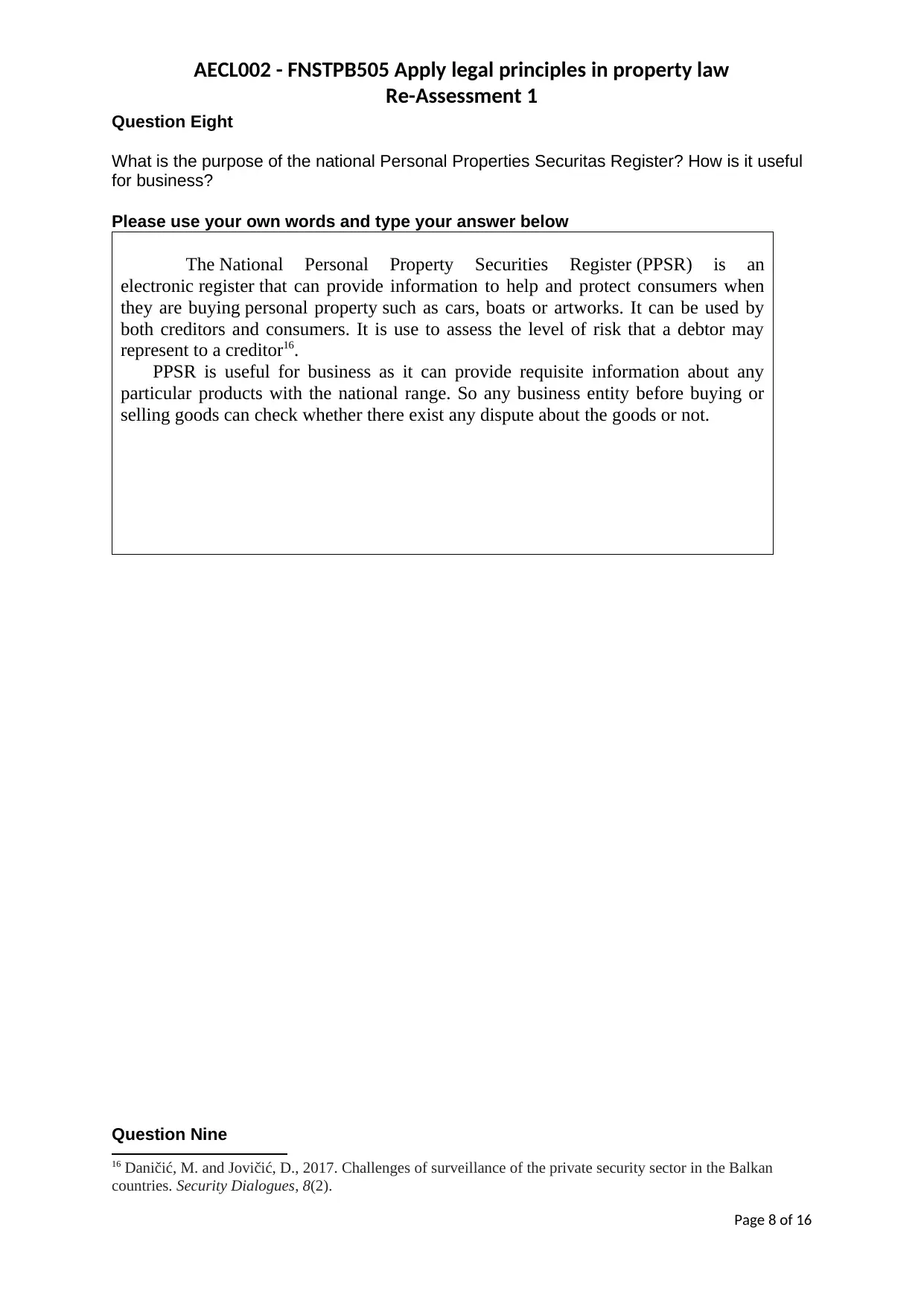
AECL002 - FNSTPB505 Apply legal principles in property law
Re-Assessment 1
Question Eight
What is the purpose of the national Personal Properties Securitas Register? How is it useful
for business?
Please use your own words and type your answer below
The National Personal Property Securities Register (PPSR) is an
electronic register that can provide information to help and protect consumers when
they are buying personal property such as cars, boats or artworks. It can be used by
both creditors and consumers. It is use to assess the level of risk that a debtor may
represent to a creditor16.
PPSR is useful for business as it can provide requisite information about any
particular products with the national range. So any business entity before buying or
selling goods can check whether there exist any dispute about the goods or not.
Question Nine
16 Daničić, M. and Jovičić, D., 2017. Challenges of surveillance of the private security sector in the Balkan
countries. Security Dialogues, 8(2).
Page 8 of 16
Re-Assessment 1
Question Eight
What is the purpose of the national Personal Properties Securitas Register? How is it useful
for business?
Please use your own words and type your answer below
The National Personal Property Securities Register (PPSR) is an
electronic register that can provide information to help and protect consumers when
they are buying personal property such as cars, boats or artworks. It can be used by
both creditors and consumers. It is use to assess the level of risk that a debtor may
represent to a creditor16.
PPSR is useful for business as it can provide requisite information about any
particular products with the national range. So any business entity before buying or
selling goods can check whether there exist any dispute about the goods or not.
Question Nine
16 Daničić, M. and Jovičić, D., 2017. Challenges of surveillance of the private security sector in the Balkan
countries. Security Dialogues, 8(2).
Page 8 of 16
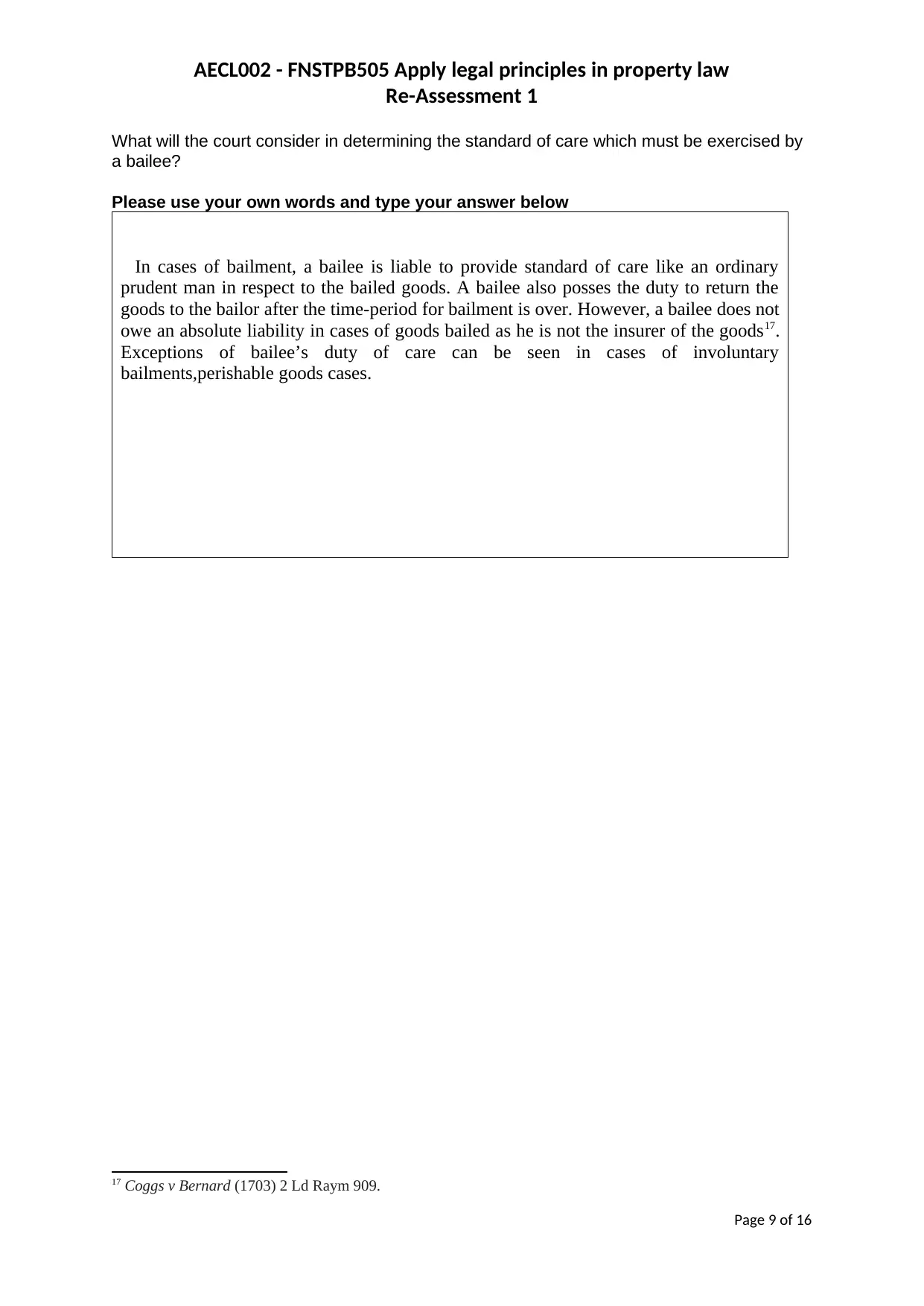
AECL002 - FNSTPB505 Apply legal principles in property law
Re-Assessment 1
What will the court consider in determining the standard of care which must be exercised by
a bailee?
Please use your own words and type your answer below
In cases of bailment, a bailee is liable to provide standard of care like an ordinary
prudent man in respect to the bailed goods. A bailee also posses the duty to return the
goods to the bailor after the time-period for bailment is over. However, a bailee does not
owe an absolute liability in cases of goods bailed as he is not the insurer of the goods17.
Exceptions of bailee’s duty of care can be seen in cases of involuntary
bailments,perishable goods cases.
17 Coggs v Bernard (1703) 2 Ld Raym 909.
Page 9 of 16
Re-Assessment 1
What will the court consider in determining the standard of care which must be exercised by
a bailee?
Please use your own words and type your answer below
In cases of bailment, a bailee is liable to provide standard of care like an ordinary
prudent man in respect to the bailed goods. A bailee also posses the duty to return the
goods to the bailor after the time-period for bailment is over. However, a bailee does not
owe an absolute liability in cases of goods bailed as he is not the insurer of the goods17.
Exceptions of bailee’s duty of care can be seen in cases of involuntary
bailments,perishable goods cases.
17 Coggs v Bernard (1703) 2 Ld Raym 909.
Page 9 of 16
⊘ This is a preview!⊘
Do you want full access?
Subscribe today to unlock all pages.

Trusted by 1+ million students worldwide
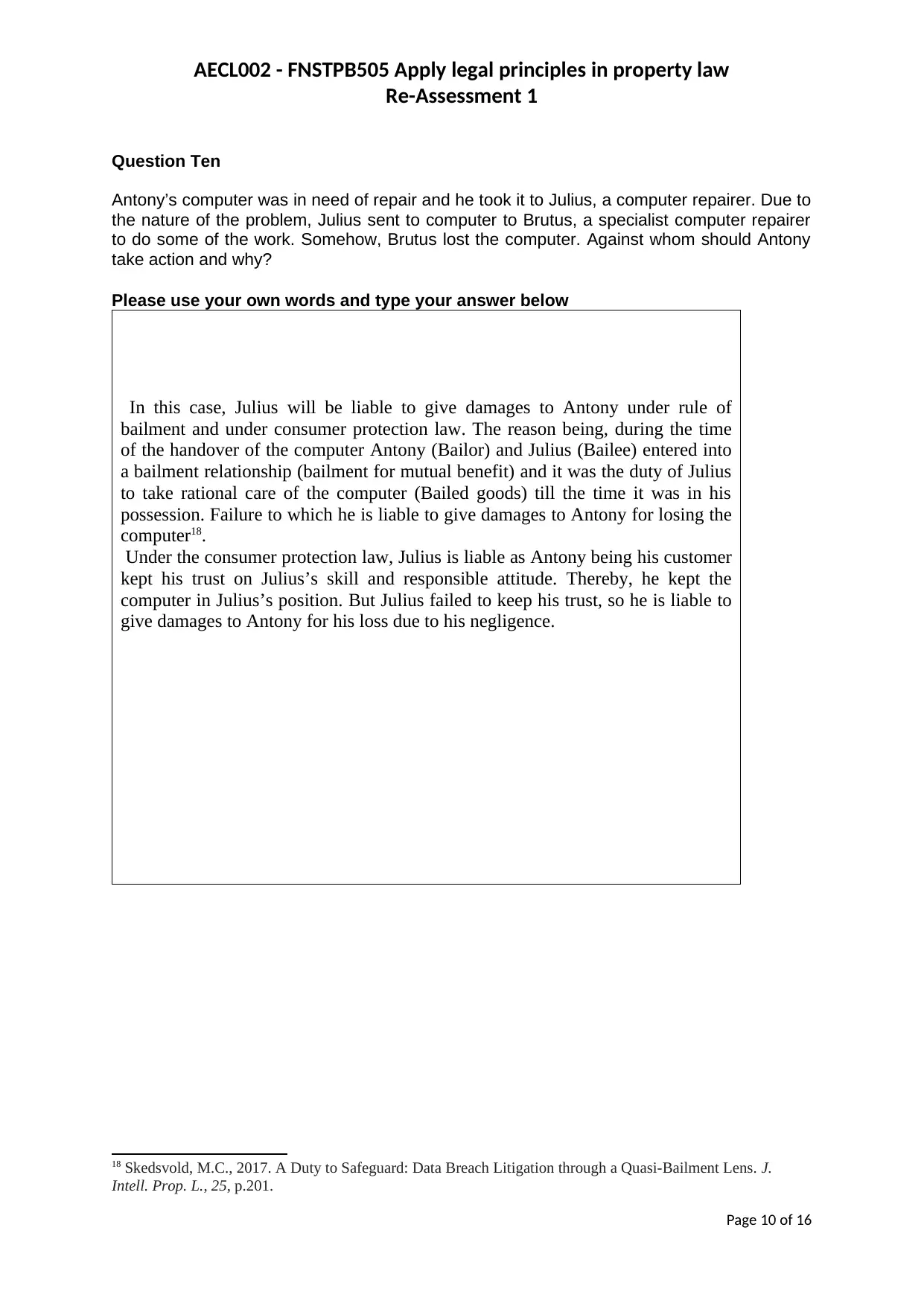
AECL002 - FNSTPB505 Apply legal principles in property law
Re-Assessment 1
Question Ten
Antony’s computer was in need of repair and he took it to Julius, a computer repairer. Due to
the nature of the problem, Julius sent to computer to Brutus, a specialist computer repairer
to do some of the work. Somehow, Brutus lost the computer. Against whom should Antony
take action and why?
Please use your own words and type your answer below
In this case, Julius will be liable to give damages to Antony under rule of
bailment and under consumer protection law. The reason being, during the time
of the handover of the computer Antony (Bailor) and Julius (Bailee) entered into
a bailment relationship (bailment for mutual benefit) and it was the duty of Julius
to take rational care of the computer (Bailed goods) till the time it was in his
possession. Failure to which he is liable to give damages to Antony for losing the
computer18.
Under the consumer protection law, Julius is liable as Antony being his customer
kept his trust on Julius’s skill and responsible attitude. Thereby, he kept the
computer in Julius’s position. But Julius failed to keep his trust, so he is liable to
give damages to Antony for his loss due to his negligence.
18 Skedsvold, M.C., 2017. A Duty to Safeguard: Data Breach Litigation through a Quasi-Bailment Lens. J.
Intell. Prop. L., 25, p.201.
Page 10 of 16
Re-Assessment 1
Question Ten
Antony’s computer was in need of repair and he took it to Julius, a computer repairer. Due to
the nature of the problem, Julius sent to computer to Brutus, a specialist computer repairer
to do some of the work. Somehow, Brutus lost the computer. Against whom should Antony
take action and why?
Please use your own words and type your answer below
In this case, Julius will be liable to give damages to Antony under rule of
bailment and under consumer protection law. The reason being, during the time
of the handover of the computer Antony (Bailor) and Julius (Bailee) entered into
a bailment relationship (bailment for mutual benefit) and it was the duty of Julius
to take rational care of the computer (Bailed goods) till the time it was in his
possession. Failure to which he is liable to give damages to Antony for losing the
computer18.
Under the consumer protection law, Julius is liable as Antony being his customer
kept his trust on Julius’s skill and responsible attitude. Thereby, he kept the
computer in Julius’s position. But Julius failed to keep his trust, so he is liable to
give damages to Antony for his loss due to his negligence.
18 Skedsvold, M.C., 2017. A Duty to Safeguard: Data Breach Litigation through a Quasi-Bailment Lens. J.
Intell. Prop. L., 25, p.201.
Page 10 of 16
Paraphrase This Document
Need a fresh take? Get an instant paraphrase of this document with our AI Paraphraser
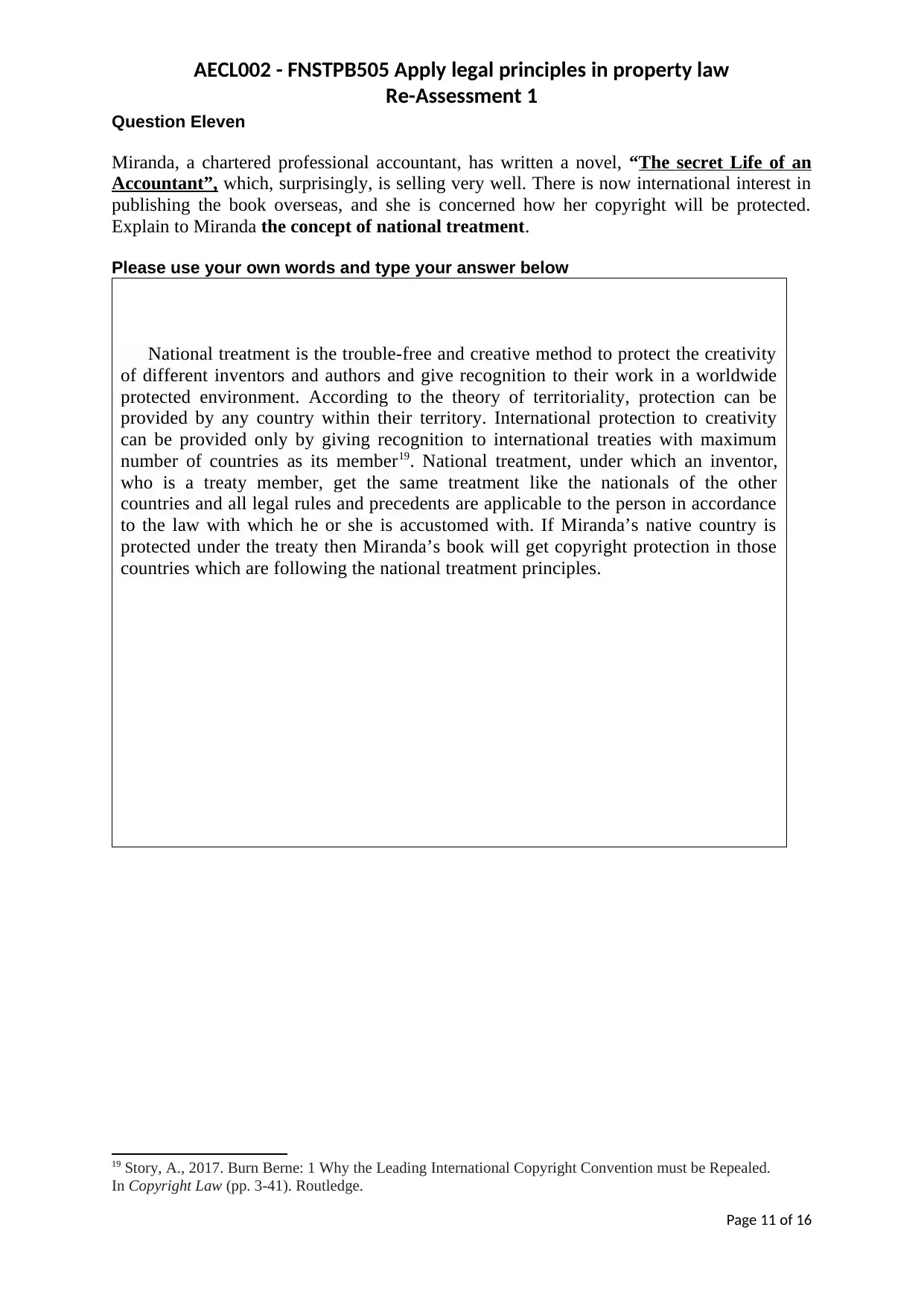
AECL002 - FNSTPB505 Apply legal principles in property law
Re-Assessment 1
Question Eleven
Miranda, a chartered professional accountant, has written a novel, “The secret Life of an
Accountant”, which, surprisingly, is selling very well. There is now international interest in
publishing the book overseas, and she is concerned how her copyright will be protected.
Explain to Miranda the concept of national treatment.
Please use your own words and type your answer below
National treatment is the trouble-free and creative method to protect the creativity
of different inventors and authors and give recognition to their work in a worldwide
protected environment. According to the theory of territoriality, protection can be
provided by any country within their territory. International protection to creativity
can be provided only by giving recognition to international treaties with maximum
number of countries as its member19. National treatment, under which an inventor,
who is a treaty member, get the same treatment like the nationals of the other
countries and all legal rules and precedents are applicable to the person in accordance
to the law with which he or she is accustomed with. If Miranda’s native country is
protected under the treaty then Miranda’s book will get copyright protection in those
countries which are following the national treatment principles.
19 Story, A., 2017. Burn Berne: 1 Why the Leading International Copyright Convention must be Repealed.
In Copyright Law (pp. 3-41). Routledge.
Page 11 of 16
Re-Assessment 1
Question Eleven
Miranda, a chartered professional accountant, has written a novel, “The secret Life of an
Accountant”, which, surprisingly, is selling very well. There is now international interest in
publishing the book overseas, and she is concerned how her copyright will be protected.
Explain to Miranda the concept of national treatment.
Please use your own words and type your answer below
National treatment is the trouble-free and creative method to protect the creativity
of different inventors and authors and give recognition to their work in a worldwide
protected environment. According to the theory of territoriality, protection can be
provided by any country within their territory. International protection to creativity
can be provided only by giving recognition to international treaties with maximum
number of countries as its member19. National treatment, under which an inventor,
who is a treaty member, get the same treatment like the nationals of the other
countries and all legal rules and precedents are applicable to the person in accordance
to the law with which he or she is accustomed with. If Miranda’s native country is
protected under the treaty then Miranda’s book will get copyright protection in those
countries which are following the national treatment principles.
19 Story, A., 2017. Burn Berne: 1 Why the Leading International Copyright Convention must be Repealed.
In Copyright Law (pp. 3-41). Routledge.
Page 11 of 16
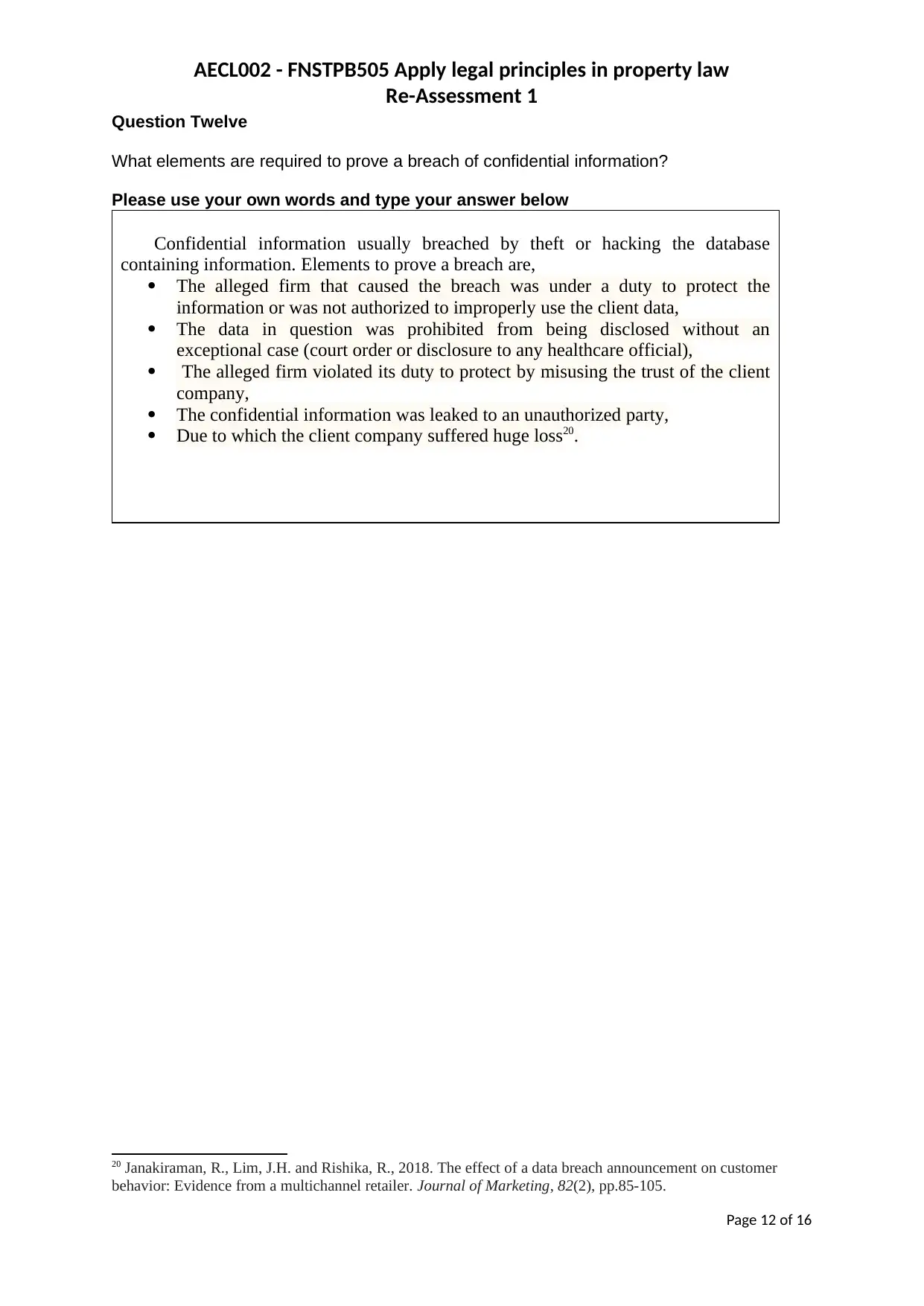
AECL002 - FNSTPB505 Apply legal principles in property law
Re-Assessment 1
Question Twelve
What elements are required to prove a breach of confidential information?
Please use your own words and type your answer below
Confidential information usually breached by theft or hacking the database
containing information. Elements to prove a breach are,
The alleged firm that caused the breach was under a duty to protect the
information or was not authorized to improperly use the client data,
The data in question was prohibited from being disclosed without an
exceptional case (court order or disclosure to any healthcare official),
The alleged firm violated its duty to protect by misusing the trust of the client
company,
The confidential information was leaked to an unauthorized party,
Due to which the client company suffered huge loss20.
20 Janakiraman, R., Lim, J.H. and Rishika, R., 2018. The effect of a data breach announcement on customer
behavior: Evidence from a multichannel retailer. Journal of Marketing, 82(2), pp.85-105.
Page 12 of 16
Re-Assessment 1
Question Twelve
What elements are required to prove a breach of confidential information?
Please use your own words and type your answer below
Confidential information usually breached by theft or hacking the database
containing information. Elements to prove a breach are,
The alleged firm that caused the breach was under a duty to protect the
information or was not authorized to improperly use the client data,
The data in question was prohibited from being disclosed without an
exceptional case (court order or disclosure to any healthcare official),
The alleged firm violated its duty to protect by misusing the trust of the client
company,
The confidential information was leaked to an unauthorized party,
Due to which the client company suffered huge loss20.
20 Janakiraman, R., Lim, J.H. and Rishika, R., 2018. The effect of a data breach announcement on customer
behavior: Evidence from a multichannel retailer. Journal of Marketing, 82(2), pp.85-105.
Page 12 of 16
⊘ This is a preview!⊘
Do you want full access?
Subscribe today to unlock all pages.

Trusted by 1+ million students worldwide
1 out of 16
Your All-in-One AI-Powered Toolkit for Academic Success.
+13062052269
info@desklib.com
Available 24*7 on WhatsApp / Email
![[object Object]](/_next/static/media/star-bottom.7253800d.svg)
Unlock your academic potential
Copyright © 2020–2025 A2Z Services. All Rights Reserved. Developed and managed by ZUCOL.

